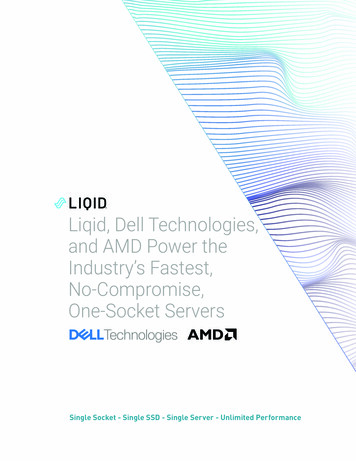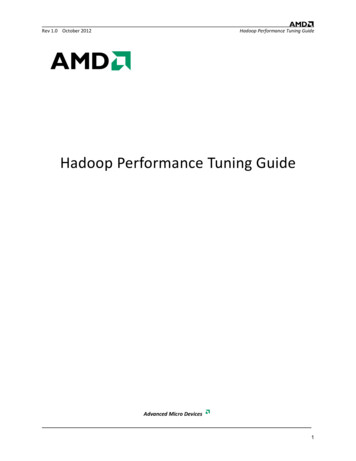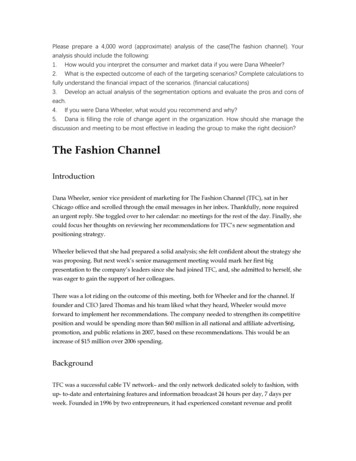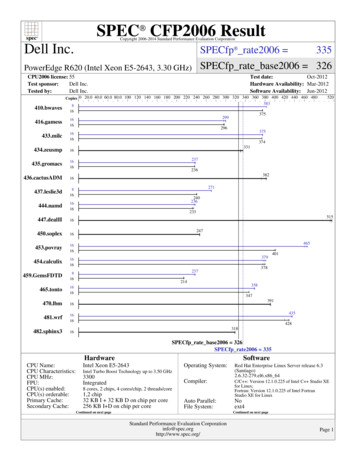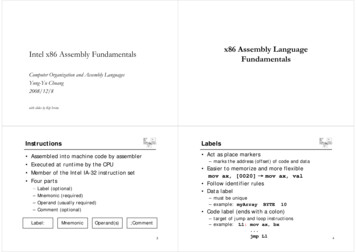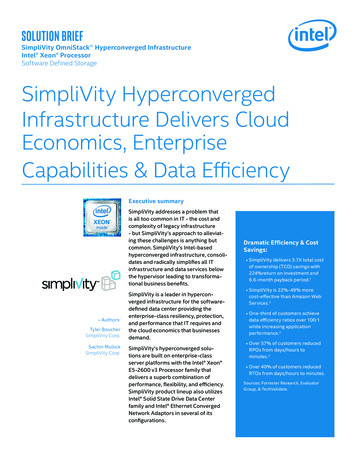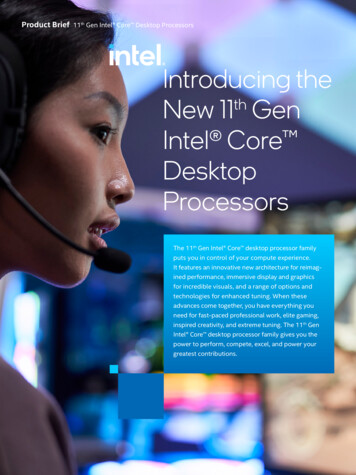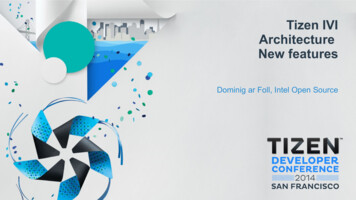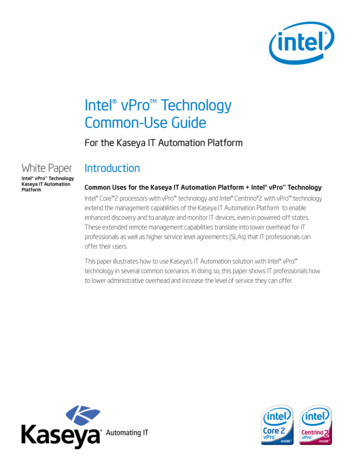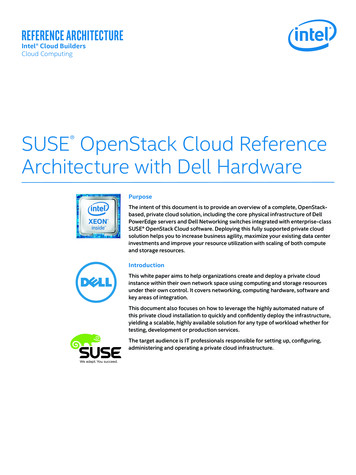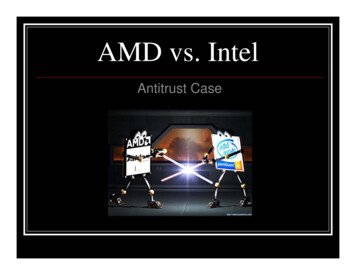
Transcription
AMD vs. IntelAntitrust Case
What is the semiconductor business? History, CompanyProfiles, Market Share Semiconductor Industry – What is a semiconductor? Industry in which firms deal with the designing and fabricating ofsemiconductor devices A semiconductor is a solid material that has electrical conductivity thatis situated in between a conductor and an insulator Semiconductors are powering devices that are key to making cellularphones, computer hardware, and other electronic components.Semiconductor Industry – World Market/ Structure Dominated by United States, EU, Japan, and South Korea A 230 billion per year industry US market face government regulation inhibiting growth Research and Development intensive Capital intensive Economic stimulus for the electronics business, 10% of world GDP
Semiconductor Industry Continued. Semiconductor Industry – Intel #1 in semiconductor industry Based in Santa Clara, CA 86,300 employees Revenue 2007: 38 Billion 2007 Mercury Research: 80% market shareSemiconductor Industry – AMD Intel’s main competitor Based in Sunnyvale, CA 16,420 employees Revenue 2007: 6 Billion 2007 Mercury Research: 18% market share
AMD-Intel: A Brief History and Introduction into thecases x86 chip: Most used chip in computers, Intel processors account for morethan 80 percent of the computers running x86-based chipsIn the early 1980’s IBM signed with Intel to develop microprocessor chipx86 but did not want to give Intel monopoly power so they demanded acontract with AMD as a second sourceIntel attempted to preserve the appearance that AMD was their secondsource while actually planning a sole-source project: secret plan foracquiring and maintaining monopoly in x86 microprocessors by 19871992-AMD awarded 10 million after court case against Intel-prospectivereturn to competitionAMD’s market share has not kept pace with their technological innovation.They claim Intel’s misconduct is the reason.
AMD-Intel: A Brief History and Introduction into thecases Japan Case: illegal tactics by offering money to 5 Japanesecompanies(NEC, Fujitsu, Toshiba, Sony, and Hitachi)EU Case: AMD alleges that Intel paid German retailers to sell IntelPC's onlyUS Case: Making exclusive deals with Dell, Sony, Toshiba,Gateway and Hitachi that included cash payments, subsidies,discriminatory pricing to exclude AMD
Break FreeAMD has alleged that Intel is, in short, paying and pressuring computer manufacturers toboycott AMD. in doing this, Intel is breaking national and international “competition”or “antitrust” laws, laws that focus on: Prohibiting agreements or practices that restrict free trading andcompetition between business entities.banning abusive behavior by a firm dominating a market, or anticompetitive practices that tend to lead to such a dominant position.supervising the mergers and acquisitions of large corporations
Competition Matters Intel's response is "an attempt to divert attention from what this case isreally about. Crossing swords of rhetoric is fun, but it's time to put the truthon the table in the courtroom. The industry problem is that [computermanufacturers and retailers] are under threats from retaliatory andpotentially lethal price increases by Intel if they give too much business toAMD.“ - Thomas McCoyWe applaud aggressive competition, so long as it occurs on a level playingfield where products can compete on the merits. Unfortunately, this is notthe case. Intel uses its monopoly power to perpetuate its monopoly grip onthe market, and by any standard of antitrust law, that is illegal and patentlyanti-consumer.Worldwide antitrust laws are clear: Abusive conduct to curb competition bya dominant monopoly is against the law. That's why we've filed a lawsuitagainst Intel, to help AMD, our industry and consumers worldwide breakfree from a stranglehold that has deliberately restricted competition andslowed the pace of innovation.‐Hector Ruiz, CEO of AMD
Intel’s Response Specifically, Intel points to AMD's "playing it safe . with anemic investmentin manufacturing capacity, leaving Intel to shoulder the burden ofinvestment to enhance the usefulness of computers and enhance themarket." In addition, Intel claims AMD has been "dogged" by a reputation ofbeing unreliable as a supplier, has traditionally lagged in innovation, andhas seen products delayed well beyond original launch dates. AMD only has itself to blame for failing in the marketplace When AMD delivered on time, it gained market share. Intel has no controlover their delivery schedules; that is completely in AMD’s hands, they justaren’t living up to their customers and it shows with their market share.
Intel’s Response Continued. Intel said it has demonstrated over a 30-year period that it can deliver faster,better, and cheaper products to consumers, in part because of its continuedmultibillion-dollar investment in new capacity and research anddevelopment even during downturns in the semiconductor market."In short," Intel wrote in its response, "AMD's colorful language and fancifulclaims cannot obscure its goal of shielding the company from pricecompetition."“Intel's AMD AntitrustRebuttal: We're Not Bad,You're Just Stupid”
AMD and Intel International Antitrust CasesAccording to market research company I.D.C.Between 2003 and 2004 AMD's market share in of Japanese computers dipped to 14%from 16%By 2005 Intel processors account for more than 80% of the computersrunning x86-based chips.
AMD in Japan files claimJune 2005 Tokyo High Court and Tokyo District Court receive claim AMD Seeks 50 million in damages Japanese Fair Trade Commission verified AMD’s hunch of Intelinterference with PC manufactures
AMD was right about Intel in JapanJuly 2005 The JFTC investigations turned up a deal between PC manufacturingcompanies, NEC, Fujitsu, Toshiba, Sony, and Hitachi, and el. These companies had agreed to only use Intel chips This deal is in violation of Japanese antimonopoly policy, and themanufacturing companies had to accept other x86 chip developers
German AMD claim Intel is violating antitrustlawsJuly 2006 German AMD filled a claim that Intel teamed with Media Markt, a retailer ofPC’sSeptember 2006 The European Commission investigates the German Intel and Media Marktdeal
AMD keeps pressuring ECJuly 2007 The European Commission finds Intel and Media Markt guilty of breakingantitrust lawsFeb 2008 The deal between Intel and MM is still under investigation
US Antitrust Case: AMD vs. Intel Filed in United States District Court of DelawareAMD claims that Intel "unlawfully maintained its monopoly by engaging in arelentless, worldwide campaign to coerce customers to refrain from dealingwith AMD" for more than ten years.
AMD file antitrust lawsuit against Intel inUnited States District Court in Delaware "You don't have to take our word for it when it comes to Intel's abuses; theJapanese government condemned Intel for its exclusionary and illegalmisconduct"-Thomas McCoy, AMD's executive vice president of legal affairs and chiefadministrative officer, said in a statement.
Nature of the Action AMD competes with Intel in a global market, but Intel holds undeniablemarket power (90% of all sales) unlawfully maintained monopoly power by : Forcing major customers into exclusive deals with Intel throughdiscriminatory pricing, cash payments or subsidies conditioned onexclusion of AMD Forcing other major customers into partial exclusivity agreementsby conditioning rebates, allowances and market development fundson customers agreement to severely limit or forego entirelypurchases from AMD Establishing a system of first dollar rebates triggered by purchasesat such high levels as to have the intended effect of denyingcustomers freedom to purchase any significant volume ofprocessors from AMD
Nature of the Action Continued. Forcing PC makers and tech processors to boycott AMD productlaunches or promotionsAnd abusing its market power by forcing on the industrial technicalstandards and products which have as their main purpose thehandicapping of AMD in the marketplaceIntel’s conduct has unfairly and artificially capped AMD’s market shareand constrained it from expanding to reach minimum efficient level ofscales necessary to competeComputer manufactures continue to purchase most of theirrequirements from Intel and continue to pay monopoly pricesConsumers ultimately foot this bill in form of inflated PC prices and lossof freedom to purchase computer products that best fit their needs
US Antitrust Lawsuit Timeline June 2005: AMD files a 48-page antitrust complaint in U.S. federal districtcourt Intel Corporation has unlawfully maintained its monopoly in the x86microprocessor market through worldwide coercion of customers torefrain from dealing with AMDApril 2006: Lawyers for both parties meet in court for an initial statusconference.Sep. 2006: Intel attempt to limit case to business practices within country The U.S. court grants Intel's motion to dismiss claims arising fromAMD's sale of German-made microprocessors to foreign customersDec.2006: AMD victory in court ruling: Intel documents pertaining tointernational business practices applicable to case Since 68% of the computers containing x86 processors are sold tocustomers abroad, evidence about Intel’s “foreign conduct” was“essential” to allowing AMD to make out its case to demonstrate thatIntel has violated U.S. antitrust laws
Timeline Continued March 2007: Intel accused of withholding information-loss of potentiallymassive amounts of critical evidence Email correspondence generated and received by top Intelexecutives and other employees since the filing of the lawsuit andmany other relevant electronic documents may be irretrievably lost.Among its mistakes, Intel relied on a highly risky preservation"honor system" which allowed an automated email purge system tocontinue throughout litigation and gave incomplete or unclearinstructions to its custodians on how to preserve files.April-May 2007: Intel required to submit report and remediation plan inregards to lost evidence Explanation of what caused lapses in evidence preservation, andtheir proposal for attempting to recover lost evidence, including emails from many executives. Legal counsel for Intel ultimatelyagrees to preserve documents detailing their own involvement inthe creation and maintenance of Intel's document preservationapparatus
Current January 2008: The allegations of Intel's anticompetitive conduct have notyet been proven or rejected in a court, "but with worldwide scrutinygrowing, the Intel case has become the landmark monopolization case ofthe twenty-first century. It is significant because the market is global andthere are only two competitors, with no anticipation of new entry.January 2008-Present: The present court case has spurred otherallegations and court cases against Intel New York Attorney General Andrew M. Cuomo served a wide-rangingsubpoena seeking documents and information on Intel Corporation.Cuomo is investigating whether Intel violated state and federal antitrustlaws by coercing customers to exclude its main rival, Advanced MicroDevices (AMD), from the worldwide market for x86 computerprocessing units New Class Action Complaint filed in Idaho: According to the complaint,Intel engaged in acts that include: the use of discriminatory rebates thathave the effect of denying customers the freedom to purchase anysignificant volume of processors from AMD and others.” – CompetitionLaw 360*
Dominant Firm with Competitive FringeAMDIntelmonopoly80%20%
Economic Study of how much Intel Benefits Done by Dr. Michael A. Williams of ERS GroupFrom 1996-2006 Intel has extracted more than 60 billion in monopolyprofitsIntel’s Total Profits (total return 25.95%) 141.8 billionCompetitive Profits (cost of capital 9.94%)- 54.2 billionResult: Economic Profits (economic return 16.01%) 87.7 billionPortion of Economic Profits Attributed to Assumed Advantages (5.0%) - 27.3 billion 60.4 billionResult: Monopoly Profits (11.01%)
How much can consumers benefit if Intel hasfewer market share? Intel microprocessor ASP – 2006Intel microprocessor ASP – 2011 (projected)Total price reduction for computer manufacturer:less)Savings passed on to consumer: Total consumer savings per computer: Over the next decade, over 80 billion can be saved from freecompetition: 61 billion for consumers and 20 billion for computermanufacturers 121.12- 101.30 19.82 (16 percent75% 14.87, or 1.5%of a 1000 performancedesktop computer
This has happened before On May 18, 1998, the United States Department of Justice, and theAttorney General of 20 States and the District of Columbia sued Microsoft. Allegations against Microsoft:Illegally monopolized the market for operation systems for personalcomputers.Had anti-competitive contractual arrangements with various vendors ofrelated goods, such as with computer manufacturers and internet serviceproviders and had taken other actions to preserve and enhances itsmonopoly.Illegally attempted to monopolize the market for Internet Browsers.Microsoft bundled its internet browsers anti-competitively with its operatingsystem.Similar to Intel: Paying and pressuring computer manufacturers toboycott Microsoft’s competitors.
Microsoft’s defenseMicrosoft Defense: Microsoft can legally add new features and functions to windows. Thebrowser is merely a feature, and not a product since consumers are payingfor the operating system and not the browser. Microsoft was merely competing and such competition is welfareenhancing. Consumers benefit from Microsoft’s actions because of its low pricingoperating system, zero pricing of its browser, and its enhancements andacceleration of the innovation process.Like Intel:Microsoft’s production is better than its competitors and its actions havebenefitted the tech industry and its consumers.
Final Judgment Microsoft shall not retaliate against an OEM for using software that iscompeting with the Microsoft platform.Microsoft will charge set royalties.Shall not restrict OEM licensees as decreed in the final judgment.Microsoft would have to make available to third parties its systems, records,and source code in order to ensure compliance.
Significance of this case “From now on the computer industry, whichhas been very fortunate in that it has beenrelatively free of government intrusion, willexperience a continuous increase ingovernment regulation. Antitrust veryquickly becomes regulation.” – MiltonFriedman
Possible Outcomes AMD Wins (4) : AMD Loses (2) Intel loses and is forced to stop its anti-competition activities as seen inJapan and Germany casesIncomplete proof of Intel’s monopolistic practices, so Intel will be warned toabstain from such activities or possibly face severe consequencesIntel will be fined heavily, but they will find every possible way not to pay
AMD-Intel: A Brief History and Introduction into the cases Japan Case: illegal tactics by offering money to 5 Japanese companies (NEC, Fujitsu, Toshiba, Sony, and Hitachi) EU Case: AMD alleges that Intel paid German retailers to sell Intel PC's only US Case: Making exclusive deals with Dell, Sony, Toshiba, Gateway and Hitachi that included cash payments, subsidies,

